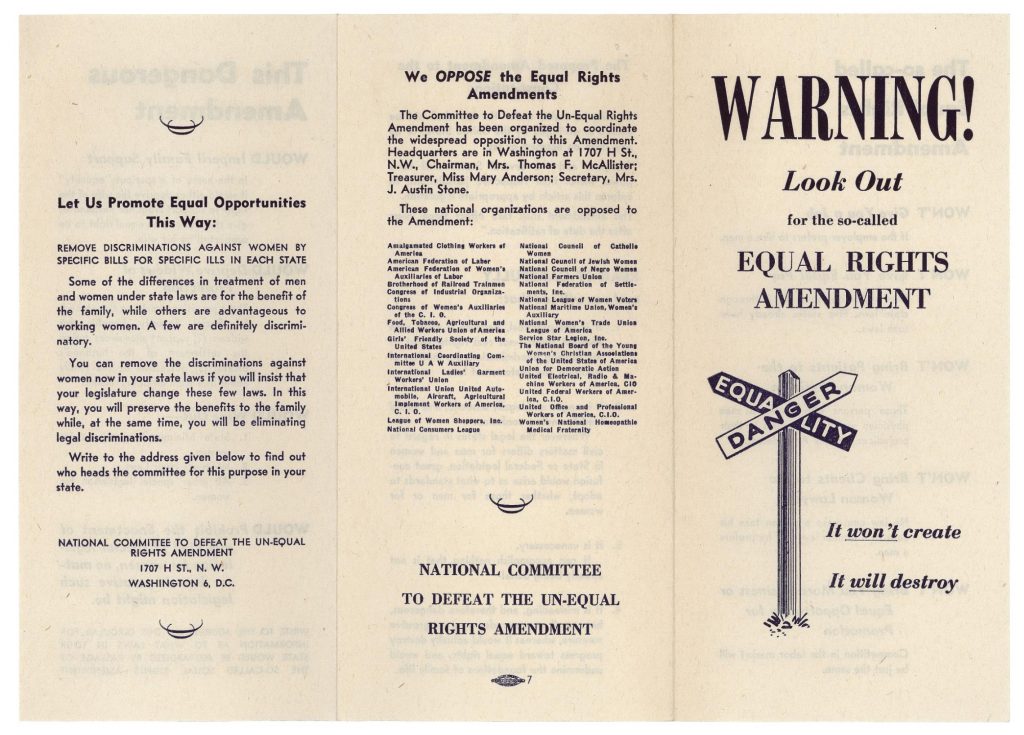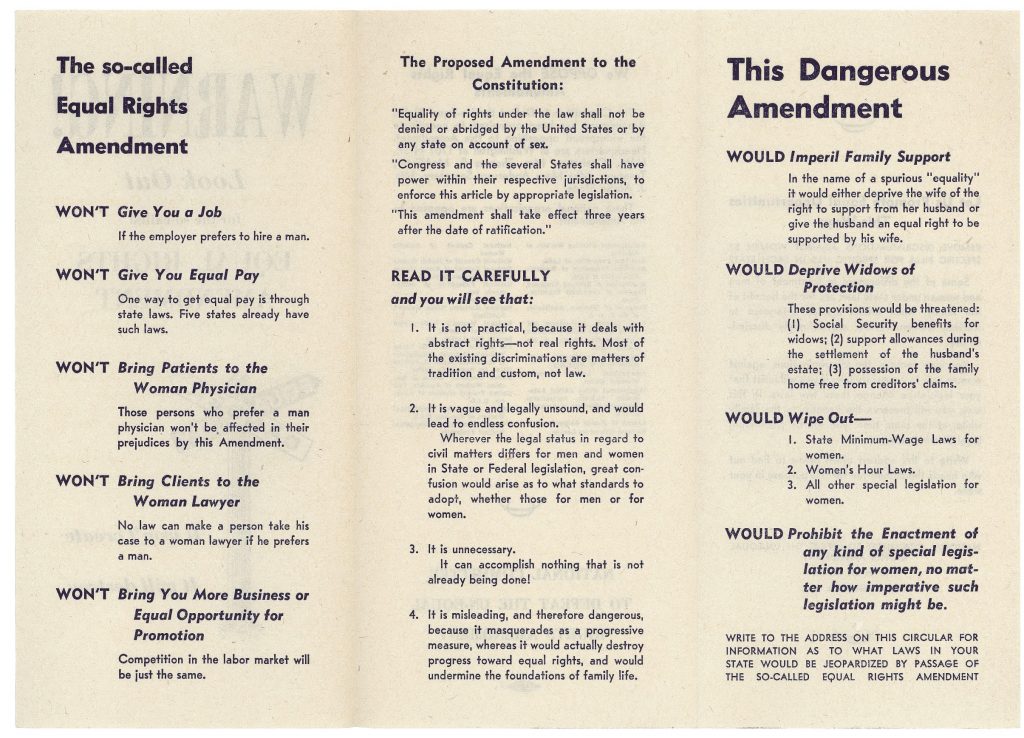Warning! Look Out for the so-called Equal Rights Amendment, in letter from Margaret Austin Stone
National Committee to Defeat the Un-Equal Rights Amendment, “Warning! Look Out for the so-called Equal Rights Amendment,” in Letter from Margaret Austin Stone of the National Committee to Defeat the Un-Equal Rights Amendment and to Promote Equal Opportunities, to Representative Hatton Sumners, 1945. U.S. House of Representatives. Committee on the Judiciary, National Archives and Records Administration.
Warning! Look Out for the so-called Equal Rights Amendment, in letter from Margaret Austin Stone
National Committee to Defeat the Un-Equal Rights Amendment, “Warning! Look Out for the so-called Equal Rights Amendment,” in Letter from Margaret Austin Stone of the National Committee to Defeat the Un-Equal Rights Amendment and to Promote Equal Opportunities, to Representative Hatton Sumners, 1945. U.S. House of Representatives. Committee on the Judiciary, National Archives and Records Administration.
Background
Although the Equal Rights Amendment (ERA) failed in the 1920s, it did not entirely disappear. For the next two decades, activists and legislators continued to debate its potential. Members of the National Women’s Party slowly chipped away at resistance and shamed government representatives for not supporting the ideal of equality. By the mid-1940s, both Republicans and Democrats supported the amendment in Congress.
The possibility of ERA approval motivated anti-ERA women to mobilize. The National Committee to Defeat the Un-Equal Rights Amendment was a coalition of 20 organizations that lobbied together against the amendment. These organizations included labor unions that gained momentum during the Great Depression and the war. They brought new energy to an old argument. They reiterated that many women relied on the protection of the government. Hazardous work conditions and long hours of labor were kept in check through laws that could not exist under the ERA.
The Committee and its supporters, which included notable figures like Frances Perkins, Carrie Chapman Catt, and Mary McLeod Bethune, succeeded. In July 1946, the Senate failed to meet the two-thirds majority required to pass a constitutional amendment.
This collective action against the ERA marked an important moment in the fight for women’s rights. Progressive Era feminism was nearly dead. It lacked strong leadership and struggled to attract women who were willing to value ideals over realistic policies that enforced change.
About the Document
This resource shows two pages from a pamphlet produced by the National Committee to Defeat the Un-Equal Rights Amendment. Committee leaders distributed it to members of Congress in 1945.
Vocabulary
- amendment: A change or addition, in this case, to the United States Constitution.
- coalition: An alliance or group of separate entities that works toward a unified goal.
- Equal Rights Amendment (ERA): A proposed amendment to the United States Constitution stating that rights may not be denied on the basis of a person’s sex.
- National Committee to Defeat the Un-Equal Rights Amendment: A group made up of different organizations that opposed the ERA.
- National Woman’s Party: An activist group and political party founded by Alice Paul and other suffragists who separated from the National American Woman Suffrage Association in 1916.
- protective legislation: Laws that are intended to protect a specific group of people from dangers, abuse, or mistreatment.
Discussion Questions
- Which organizations are included on the committee’s list of members? What do you notice about these organizations? Why do you think these particular organizations opposed the ERA?
- Read the proposed amendment. What is the ERA and what would it do?
- What is the overarching argument of the committee? What specific evidence do they give to support their argument?
- Why do you think opponents to the ERA saw it as an abstract right that would not address real life? What does this tell you about the realities of achieving and maintaining gender equality?
- What do you think of their argument? To what extent do you agree or disagree? Why?
- Why do you think the Committee was successful in its efforts? What made them convincing to Congress?
Suggested Activities
- APUSH Connection: 7.14: Postwar Diplomacy
- AP Government Connections:
- 1.3: Government power and individual rights
- 1.9: Federalism in action
- Learn more about the ERA by combining this resource with the ERA resource in the Jazz Age section of this unit.
- One of the greatest factors in the debate over the ERA was the existence of protective legislation the enforced fair (and sometimes equal) treatment of women in the workplace. Learn more about protective legislation by reading about the Goesaert v. Cleary and Muller v. Oregon decisions.
- This document marks a period when feminism, as it was defined in the Progressive Era, faded. Connect this resource to the “What Is Feminism?” broadside in the Modernizing America: 1889—1920 unit to learn more about the origins of feminism.
- Neither Mary McLeod Bethune nor Eleanor Roosevelt supported the ERA. Read these women’s life stories and think about why they did not support the ERA’s ideals.
- The Women’s Bureau’s leadership opposed the ERA too. Read the Women’s Bureau report about post-war work and consider how women’s work options might have been disrupted by the ERA.
Themes
AMERICAN IDENTITY AND CITIZENSHIP; POWER AND POLITICS; ACTIVISM AND SOCIAL CHANGE








